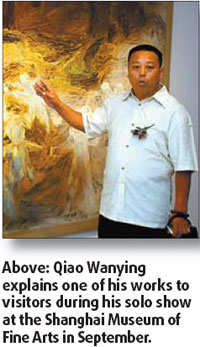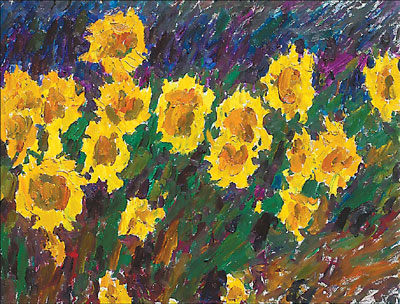Colors of his soul
Qiao Wanying often disappears into the countryside for days, or even weeks. Wild flowers may capture his attention or lush forests may lure him into their shadows and light. After enjoying intimate moments with Mother Nature, he drives home in his pick-up truck, which is full of new creations and works of wonder. With a stocky and strong build, the 47-year-old from a small village of North China's Shanxi Province smiles heartily, exposing his flawed teeth.

When Qiao speaks, people listen. Excited visitors attending Qian's oil painting solo show in September at the Shanghai Museum of Fine Arts were quick to compare him to Vincent van Gogh. But Qiao disagrees.
"I discovered him (Van Gogh) only years after I did my first oil paintings. And unlike Van Gogh, when I paint, my heart is not filled with sadness, anger, or anxiety but great joy," Qiao points out. Nor does he agree with the title of "artist". "I am a small businessman born in a farmer's family," he says. "It is just that I happen to express myself through oil paintings, which may seem strange to people who do not know me well."
Over the past few years, Qiao's impressive oil paintings have won him a growing number of fans, among them some prominent art professors and critics.
However the devout Buddhist rarely sells his works.
"At the first sight, I was instantly struck by the somewhat clumsy and rough nature of his works, but also their soul-stirring beauty," says Beijing-based art critic Jia Fangzhou who curated Qiao's exhibition in Shanghai.
Qiao's paintings are wrought in bright colors with seemingly unpolished composition, forceful lines, dots, strokes and chunks of pigment.
Zhao Kang, a visitor from Shanghai, wrote on the visitors' book: "Qiao's works, especially the vivid depiction of the thriving sunflowers, moved me so much. For a moment, I kind of felt that these lovely plants were singing and dancing under the bright sunshine. He has captured the soul of Mother Nature in his oils."
On display at the Shanghai exhibition entitled My Homeland are some 80 selected works, mainly featuring landscapes around the Juren Village, and people Qiao has known since childhood.
It is noticeable that Qiao's works have been created in widely differing styles over the years. Some deal with the subject in a realistic manner; some delve into the artist's inner feelings and look like visualized memories or dreams.
And others are similar to cave drawings and paper cuttings but rendered in a more powerful and bolder manner. Some marvel at the imageries that are usually seen in rural North China but brought out to life by Qiao with unrealistic, and contrasting colors.
At a seminar during the Shanghai exhibition, some painters and critics suggested that Qiao stick to one style and keep improving it.
But the farmer painter admits: "It is impossible for me to do so. I get down to paint when I feel a strong urgent need to do so. But when I am doing it, I have no clear idea of the final look of my work."
Born in 1961 in the mountainous Xiyang County of Shanxi, Qiao lived a life no different from other rural kids.
|
Sunflower by Qiao Wanying. Photos courtesy of Qiao Wanying |
He rose early and walked through winding mountainous paths to school, played with his peers in the valleys and at the rivers, sometimes helped his family in the terraced fields, and from time to time dreamed of traveling someday to the big world.
From an early age, Qiao has been extremely curious about nature and the universe, which led to a lifelong habit of reading. On his book list are not only Chinese literary classics and Buddhist sutras but also Stephen Hawking's A Brief History of Time, and Albert Einstein's Theory of Relativity.
Qiao cherished a simple but deep love for art from an early age. He likes to draw pictures to express his "crazy ideas" about the twinkling stars, the lightning and world of the ants. He was also fond of watching his grandma make handicrafts, such as paper cuttings, or listening to his grandpa humming local opera lines.
The impoverished family could not afford to pay for his further education in fine arts. Nor could anyone give him any practical advice on how, where and what to learn, Qiao says. Qiao began to work in a local hardware store after his graduation in 1978 from high school.
"Like my brothers and sisters, I am the child of farmers," Qiao says. "But oil painting is purely a need of my soul."
Qiao owns an interior decoration company in Xiyang County. It employs 200 people and its profits help finance a local home for senior citizens in Juren Village. He lives in the village in an undecorated, simple house with his wife and elderly parents.
His formal learning started in 1986 when he came to Beijing. He used all his savings to attend short-term training courses in the Central Academy of Fine Arts and the Art Academy of the People's Liberation Army. "I do not drink or smoke. Painting is my only luxury. In the process of painting, I feel a strong sense of tranquility and an enduring inner joy," claims Qiao.
He often leaves behind the burden of running his company to his wife and his younger brother and "disappears" into the countryside. "I do not like the rattling noise on the streets. But I love the chirping of birds and singing of insects very much. Sometimes, I even feel that the plants are talking to me in their own languages," says Qiao.
Before picking up a paintbrush, Qiao says, he often allows himself to fall into a trance-like state of mind. "I begin painting only when I get into the right mood and cannot stop myself from painting," Qiao says.
But sometimes he pulls himself back to "normal" only to find that his work is just half done. "In those cases, I cannot figure out how to continue my work. I have to leave it as it is," admits Qiao.
Qiao sometimes uses whatever is on hand such as a piece of cotton cloth, to produce the desired effects on the canvas. He once tried using a Chinese ink brush and rice paper without success.
According to art critic Jia Fangzhou, Qiao's works bear a strong resemblance to the Expressionist works in a sense that Qiao attempts to depict not reality but rather the subjective emotions and responses that objects and events arouse in him. But "Qiao's art is by no means an imitation of the Western masters. It is deeply-rooted in the local culture of the yellow earth; and it just grows out of his life and out of his heart," Jia says.
(China Daily 10/30/2007 page18)















